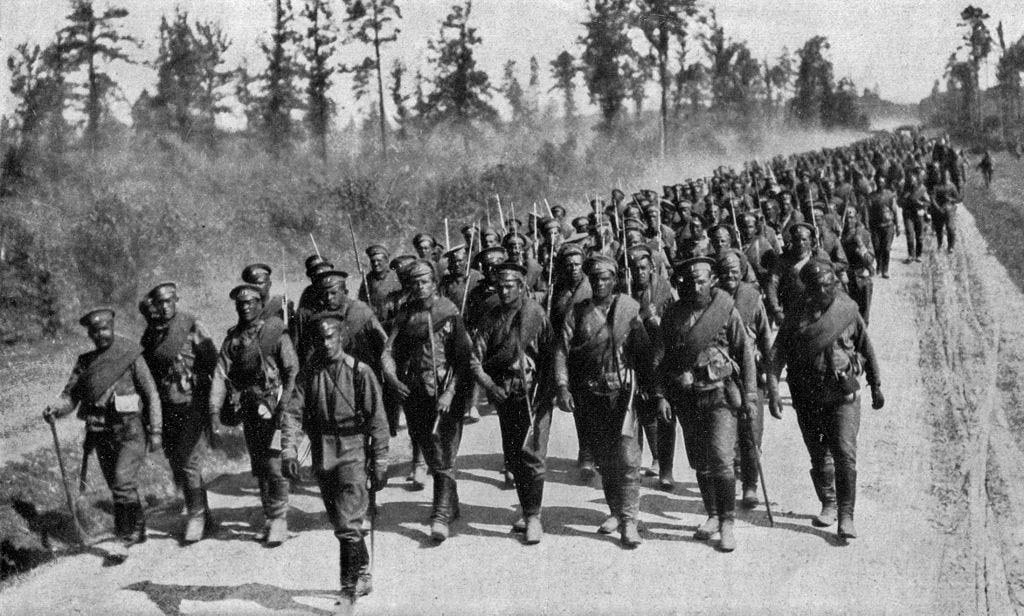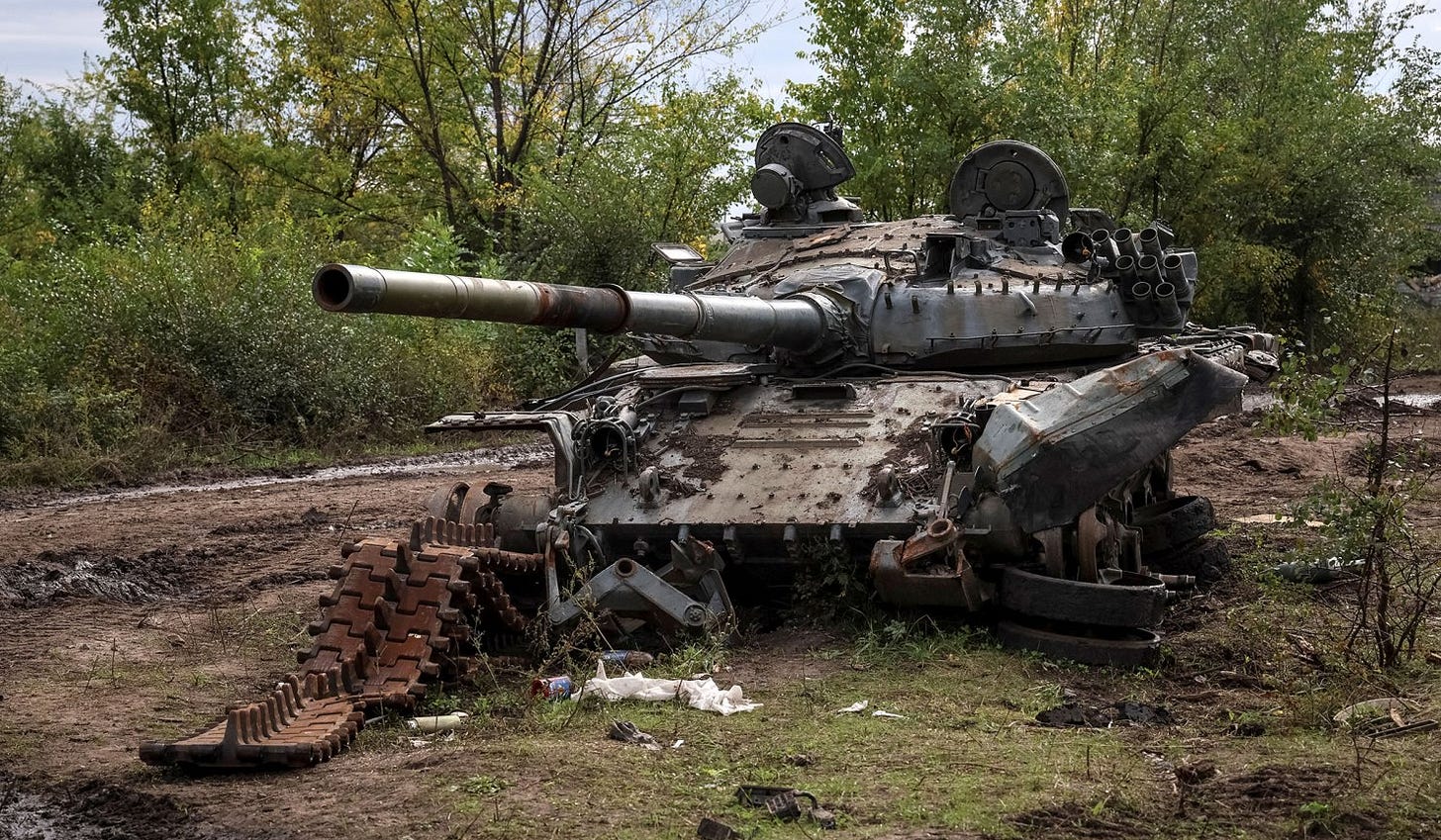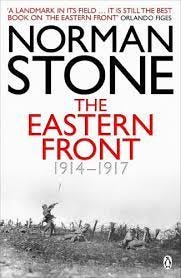Note: It now is evident that the Biden/Harris Administration botched its response to the Ukraine crisis. In February 2022, Biden & Co. judged that Russia would win the war in short order. Vice President Kamala Harris was therefore sent to Europe to offer Ukrainian President Zelensky a ride out of his country. This was a gross failure of analysis, because as things turned out Russia’s military was not the invincible steamroller that the Biden Administration supposed it to be. Every subsequent American mistake and misjudgment flowed from this failure—which has needlessly prolonged a war that should have ended long ago.
Writing in September 2022, I argued that anybody familiar with Russian military history should not have been surprised by Russia’s present military incompetence. I knew this. Why didn’t the Biden Administration?
Seventy-two hours.
That was the confident, even smug, assessment of many observers in Western Europe and America when V. Putin launched his invasion of Ukraine last February. Seventy-two hours: That was how quickly they thought Kiev would fall, leading to the collapse of all Ukrainian resistance. It was deemed likely if not inevitable that after little more than thirty years of independent existence, Ukraine would revert to its former status as a Russian vassal state.
But the Russian plan—to seize Kiev with thunderclap suddenness, deposing the Ukrainian government and replacing it with a puppet regime—misfired. And as the weeks passed with Russian troops bogged down north of Kiev, it came to be realized that Putin’s legions were far less battleworthy than previously supposed. Confronted with the spirited resistance of the Ukrainian Army and people, the invaders faltered and recoiled. There were episodes of panic and rout. The Ukrainian countryside became littered with abandoned, burned-out tanks and vehicles: tangible, humiliating evidence of the Russian Army’s surprising incompetence.
It was tangible evidence as well of the faulty judgement of the aforementioned Western observers, many of whom lay a claim to military expertise. In the six months since the Russian Army’s defeat in the battle of Kiev became obvious, that evidence has continued to pile up. Stubborn resistance to the idea that Russia is losing the war may reflect a natural reluctance to admit that one’s judgement was at fault. Among the so-called nationalist conservatives, for whom V. Putin’s histrionic Russian nationalism touches a chord, it no doubt reflects ideological embarrassment: Their narrative of the Russo-Ukrainian War has been falsified. Others, perhaps the majority, may simply find it impossible to believe that a major world power, armed to the teeth, can be defeated in war by a much smaller country.
To all such prognosticators I would simply say, as I said at the time of the Battle of Kiev: Remember Tannenberg.
There is of course no single, simple explanation of the poor performance of the Russian armed forces in the present war. On the battlefield itself, tactical, operational, and organizational factors play their part. Over the horizon, so to speak, world reaction to Russia’s act of aggression, the way in which America and Europe have rallied to Ukraine’s side, weigh in the balance as well. And of course, Ukraine has mounted a stout defense, well deserving of our admiration. In the background of these factors, however, a century of history exerts its influence. Anyone familiar with that history cannot help but think of a battle that was fought over a century ago, in what was then East Prussia: Tannenberg.
When Europe went to war in 1914, its armies and peoples were saddled with many myths. One of these was the myth of the “Russian steamroller.” There were widespread ideas that the Russian Army’s inexhaustible peasant manpower represented a force against with the Germans and Austrians could not possibly stand. Thus the French government relied on early Russian action against Germany to relieve the pressure on its own front. And the Tsar’s government, with more fidelity to its ally than common sense, undertook to do just that by launching an invasion of Germany at the earliest possible moment.
It was true that the Russian Army was very large. In August 1914 the country mobilized well over three million men in 115 infantry divisions, 24 cavalry divisions, seventeen rifle brigades and eight cavalry brigades—a force that was to grow substantially as reservists were recalled to the colors and new units were raised. Nor was this large force ill provided for by comparison with its adversaries. In August 1914 the Russian Army was well equipped with small arms (including eight machine guns per infantry regiment) and field artillery. The standard 76.2mm field gun was an excellent weapon of its type and each infantry division had 48 of them. True, the lack of light and medium field howitzers capable of high-angle fire was a serious deficiency. The infantry divisions had none and most army corps had only one artillery howitzer battalion with twelve 122mm howitzers. Heavy artillery suitable for use in the field was also in short supply; only a few corps had a heavy artillery battalion with 152mm howitzers and 107mm long-range guns. Against the Austro-Hungarian Army, which had a similar artillery deficit, this did not matter so much, but against the better-prepared German Army it was to prove a major handicap.
A “shell shortage”—shorthand for chronically inadequate supplies of weapons and munitions—indeed came to plague the Russian Army, but it only became a factor after the conclusion of the opening round against the Germans in East Prussia and the Austrians in Galicia. The shortage that bedeviled the Russian Army from the very beginning of the war was of trained staff officers, noncommissioned officers and technical troops. Most conscripts and reservists were illiterate peasants: hardy, obedient, patriotic and brave but difficult to train in any but the most rudimentary military duties. It was particularly hard to find sufficient men for those service branches requiring formal education and technical qualifications, such as the artillery, engineers, signal corps, railway troops, air service, etc. And in sharp contrast to the well-educated, well-trained noncommissioned officer corps of the German Army, Russian NCOs were usually not much better educated than the men they led.
As for the Russian Army’s senior leadership, though it included brave and able men the system was shot through with corruption and favoritism, which all too often dictated appointments to command positions. Added to this was factionalism in the officer corps, which manifested itself in wartime as a dispute between two groups: the “Northerners” who believed that Russia should make its main effort against Germany, seen as the principal enemy, and the “Southerners” who favored making the main effort against Austria-Hungary, seen as easier to defeat. In hindsight it appears that the Southerners had the better argument: Austria-Hungary's defeat would fatally have undermined Germany's strategic position. But nothing was done to implement this strategy nor, indeed, to develop any overall strategy—this thanks to the confusion of Stavka, the high command. In peacetime there had been no army general headquarters. Upon mobilization Stavka had hastily to be botched together, and in the opening round it proved unable to coordinate the operations of the field armies.
Thus the Russian Army that marched against the Germans and Austrians in August 1914 was considerably less formidable than the tally of corps, divisions and brigades led people to assume. And though the Russians scored a significant victory over the hapless Austrians, in East Prussia they met with disaster.
There is a curious kinship between that opening campaign in East Prussia and the Russian invasion of Ukraine in 2022. Briefly to describe the former, two Russian field armies were committed to the invasion. In the north, First Army attacked due west toward the East Prussian capital, Königsberg. Farther south, Second Army attacked northwest toward the Vistula River. The idea was to trap the defending Eighth Army between the two Russian pincers, encircling and destroying it. In all the Russians deployed for the East Prussian invasion nine corps with nineteen infantry divisions, two rifle brigades, eight cavalry divisions, one cavalry brigade and rather over 400,000 men. The defenders could muster four corps with nine infantry divisions (six active, three reserve), two Landwehr (militia) infantry brigades, one cavalry division, various fortress troops and about 200,000 men.
Though the Russian plan looked plausible enough on paper, it embodied some dangerous weaknesses. Prominent among these was the geographical separation of the two attacking armies. Between them lay the Masurian Lakes region, called the Angerapp-Stellung (Angerapp Position) by the Germans: an area of marsh and forest that was impassible for a large force. It would be difficult, therefore, to coordinate the movements of the two Russian armies. An army group headquarters, called Northwest Front, had been set up for this purpose, but it was situated too far in the rear to provide effective command and control. Nor did the armies themselves trouble to coordinate their movements, advancing into East Prussia without much concern for what was happening on the opposite flank. And both armies were plagued from the start by logistical problems, since in response to French entreaties the invasion was launched before their services of supply were fully concentrated.
The ill effects of command deficiencies and poor staff work were compounded by poor intelligence and lax communications security. The Russian cavalry failed in fulfilment of the only useful role remaining to it: reconnaissance. Though aircraft were available, they too failed to help commanders build up a picture of what was happening on the other side of the hill. From first to last, Russian commanders had very little idea of what the Germans were doing. And to cap this sad tale of incompetence, since coding and decoding took an inordinate amount of time the various headquarters resorted to sending radio messages in the clear. These broadcasts soon acquired an appreciative audience at Eighth Army headquarters.
Though the invasion of East Prussia caused some initial consternation on the German side, cooler heads soon prevailed. As Russian dispositions and intentions gradually became clear, the Germans realized that they could exploit their central position between the two Russian armies to strike and defeat each one separately, before they could complete their encirclement of Eighth Army. This they did with characteristic dispatch and efficiency, leaving no more than a screen of cavalry and Landwehr troops against First Army in the north while exploiting the superior East Prussian railway net to concentrate most of their forces against Second Army in the south. The Russians received no inkling of this and, to make a long story short, the German counterattack demolished Second Army while in the meantime First Army advanced but sluggishly, unaware that it faced no more than a corporal’s guard.
In all, Second Army lost 78,000 killed or wounded and 92,000 made prisoner. Three corps were annihilated and two more were chased out of East Prussia in disorder. By the end of August, the remains of Second Army amounted to less than the strength of a division: perhaps 12,000 troops in all. In the subsequent First Battle of the Masurian Lakes, First Army too was driven out of East Prussia, and though badly battered at least managed to regain Russian soil in one piece.
Failures of command, poor staff work, defective intelligence, lax communications security—the deficiencies that contributed toward defeat in the Battle of Tannenberg may also be noted in the conduct of V. Putin’s invasion of Ukraine. And today as in 1914, in the background of purely military failure are deeper flaws, rooted in the fundamental nature of despotic government.
The Army of Nicholas II was clumsy and inefficient precisely because the tsarist regime itself was clumsy and inefficient. Its façade may have been magnificent, glittering—but a glance behind the curtain disclosed indolence, incompetence, indifference, corruption and decay. Given tsarist Russia’s natural advantages, it ought to have been a great power to rival the United States. But thanks to its structural deficiencies it was the weakest, most fragile of the great powers. The poor performance of the Russian Army in 1914-17 faithfully reflected the defects of the regime it served.
V. Putin may aspire to emulate Peter the Great and Stalin, but his regime most resembles that presided over by the last tsar. In such a state the despot’s formal monopoly on power is absolute but his actual power is much less, its exercise being dependent on the loyalty and competence of underlings. But since despotism puts a premium on loyalty, competence is relegated to second place.
On the eve of the Russo-Ukraine War, there was much talk in the West about Russia’s decade-long military reform program, which supposedly had refurbished the Russian armed forces after years of decay and neglect. This notion was central to the widely held opinion that once the war began it would end quickly, with Russia victorious. But the war did not end quickly, and seven months later Russia has still not prevailed. What happened?
If we could get a look behind the blood-and-iron façade of Putin’s Russia, we would doubtless find that the resources devoted to military reform were largely squandered due to inefficiency, incompetence, and corruption. Further, we would find that V. Putin was quite unaware of what was going on. In a despotic state, nobody’s ever in a hurry to deliver bad news to the despot. And finally, we would find that the premium placed on loyalty left military competence at a discount. In a despotic state the military is one of only two institutions that can unseat the despot—the other being the organs of state security. Stalin and his henchmen were well acquainted with this conundrum, and their measures to ensure military subservience produced disaster when war came in 1941. History sometimes does repeat itself and today Putin finds himself saddled with the same problem—albeit with far less ability to fix it.
For these reasons, the so-called Russian mobilization that has just been announced is unlikely to turn things around. For mobilization plays not to Russia's strengths, such as they are, but to its principal military weakness: logistics. It's one thing to mobilize 300,000 conscripts and reservists but quite another to arm, equip and train them; organize them into platoons, companies and battalions; transport them to the theater of operations; and sustain them once they've entered combat. The course of the war so far has shown that the Russian Army's logistical support system is less than efficient. Increasing the size of the Army in the field would only make the problem worse.
Moreover, what Putin was unable to accomplish by committing the elite of his armed forces is unlikely to be accomplished by committing a rabble of poorly armed, unmotivated, resentful conscripts and reservists who'd prefer to be anywhere else— provided they're not in uniform. For all the nationalist chest-thumping, military service in Russia is deeply unpopular. Living conditions for the rank and file are dismal, and discipline is enforced with an oafish brutality reminiscent of the nineteenth century. Putin and his minions may think that emulating Stalin—introducing draconian punishments for indiscipline, shirking and cowardness—can make the troops fight. Times have changed, however: A reign of terror such as held the soldiers of the Red Army to their duty would only produce disintegration if applied against the contemporary Russian Army.
The sequel to the Battle of Tannenberg was, for Russia, a slow but inexorable process of decline, ending in 1917 with military collapse, revolution, and the overthrow of the Tsar. If V. Putin persists in his effort to destroy Ukraine as an independent nation, the same fate may very well lie in store for his army, his regime, and he himself.
For related reading on the Russo-Ukrainian War, see my articles:
A Tradition of Defeat • Forge of Victory • Vladimir Strangelove Putin
A Critique of Pure Reason • The Tradition of Terror Continues
Stalin and Putin and Ukraine • The Battalion Tactical Group
And for a fuller account of the opening round in the east see my ongoing project:
Bibliographical Note: Regarding the Great War, in America and Europe attention has long tended to focus on the sanguinary trench stalemate that prevailed on the Western Front. But the course of that war in the East, though equally portentous, is not so well understood. Norman Stone’s pioneering work, The Eastern Front 1914-17 (1975) remains the best introduction to that chapter of the war, especially as regards the Russian Army’s travails from 1914 to 1917.
Those who have read both The Eastern Front and this article will recognize my debt to Professor Stone, which I gratefully acknowledge.
Author’s Note, 23 September 2022: Many thanks to The Cosmopolitan Globalist magazine and to Claire Berlinski in particular for republishing this essay.






Also a reminder that in 1904, the same poor leadership and inadequate logistics led to a Russian defeat against a smaller adversary.
And again there, the experts were wrong (or at least the western experts; the Japanese experts were pretty good).
Thank you, Thomas. I really enjoyed this.